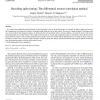Free Online Productivity Tools
i2Speak
i2Symbol
i2OCR
iTex2Img
iWeb2Print
iWeb2Shot
i2Type
iPdf2Split
iPdf2Merge
i2Bopomofo
i2Arabic
i2Style
i2Image
i2PDF
iLatex2Rtf
Sci2ools
BIOSYSTEMS
2008
2008
Decoding spike timing: The differential reverse-correlation method
It is widely acknowledged that detailed timing of action potentials is used to encode information, for example, in auditory pathways; however, the computational tools required to analyze encoding through timing are still in their infancy. We present a simple example of encoding, based on a recent model of time-frequency analysis, in which units fire action potentials when a certain condition is met, but the timing of the action potential depends also on other features of the stimulus. We show that, as a result, spike-triggered averages are smoothed so much that they do not represent the true features of the encoding. Inspired by this example, we present a simple method, differential reverse correlations, that can separate an analysis of what causes a neuron to spike, and what controls its timing. We analyze with this method the leaky integrate-and-fire neuron and show the method accurately reconstructs the model's kernel.
| Added | 08 Dec 2010 |
| Updated | 08 Dec 2010 |
| Type | Journal |
| Year | 2008 |
| Where | BIOSYSTEMS |
| Authors | Gasper Tkacik, Marcelo O. Magnasco |
Comments (0)

